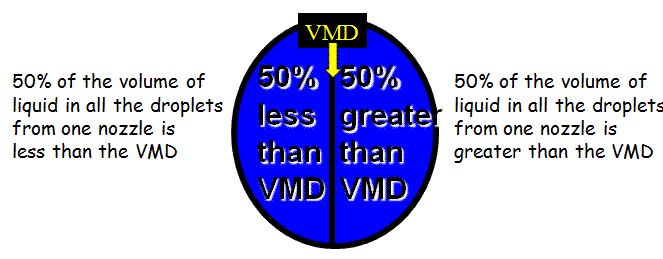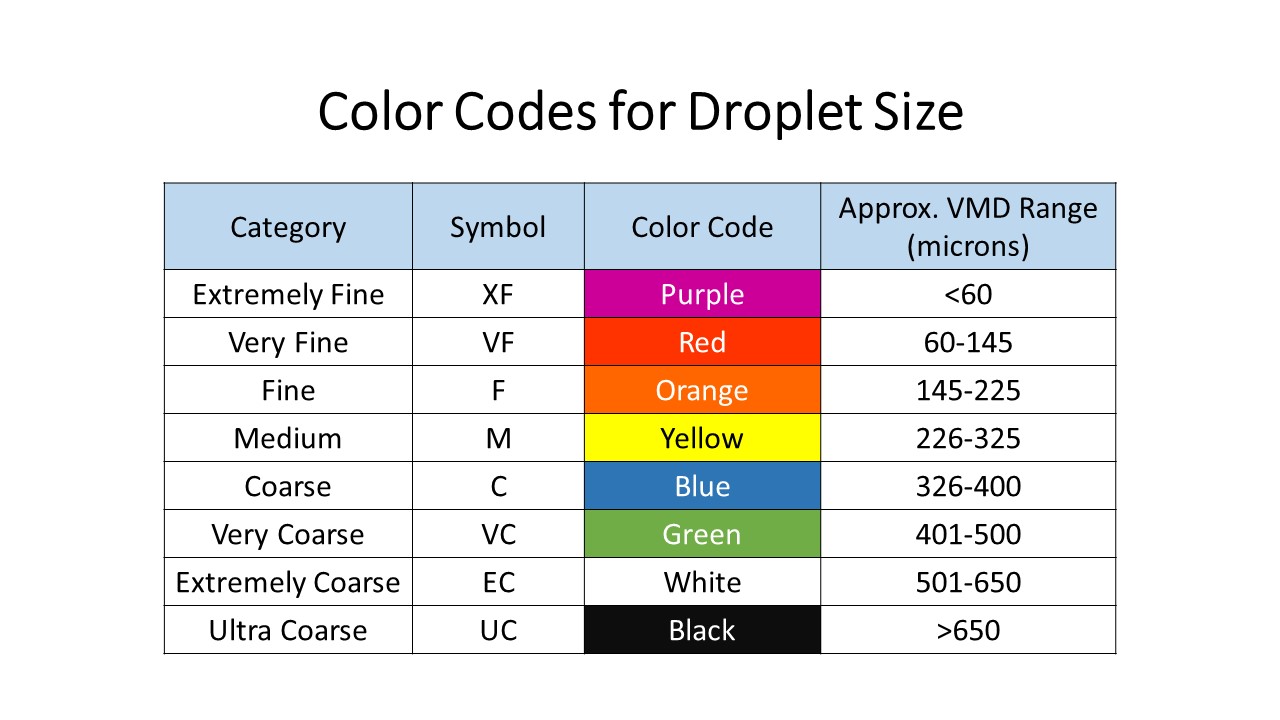During application, the pesticide spray mixture is broken into spray particles or droplets of various sizes. Managing the size of spray droplets is critical in managing spray drift.
Diameter and Weight
Droplet sizes are measured in microns. A micron is 1/1000 of a millimeter or about 1/25,000 of an inch. For perspective, human hair is about 100 microns in diameter. Spray droplets smaller than 150 microns tend to be the most prone to drift. These small droplets fall more slowly than large droplets. They do not have enough weight to overcome air resistance and are likely to float in wind currents.
Even small changes in droplet diameter make big differences in droplet weight. An increase in droplet diameter from 150 microns to about 190 microns doubles the droplet weight. An increase in droplet diameter from 150 microns to about 240 microns increases the weight 4 times. Doubling the diameter to 300 microns increases its weight, and also its volume, by 8 times. Heavier droplets fall more quickly and are less affected by air movement.
Size and Number
When the size of spray droplets is reduced, their numbers increase and the potential for drift also increases. Reducing droplet diameter in half multiplies the number of droplets by eight. The characteristics of the nozzle tip (type, fan angle, orifice size, etc.) and spray pressure have the greatest influence on droplet size.
Spray Quality
‘Spray quality’ or ‘droplet size spectrum (DSS)’ refers to the droplet sizes that a particular nozzle produces; described in terms ranging from “Extremely Fine” to “Ultra Coarse”
VMD (also known as DV0.5)
The Volume Median Diameter (VMD) refers to the midpoint droplet size (median), where half of the volume of spray is in droplets smaller, and half of the volume is in droplets larger than the median. A VMD (DV0.5) of 400, for example, indicates that half of the volume is in droplet sizes smaller than 400 microns, and half the volume is in droplet sizes larger than 400 microns. Some pesticide labels specify a recommended droplet size. An example would be: “Use nozzles producing a coarse (VMD of 400 or greater) droplet category.”

An important consideration for reducing drift is to use nozzles that produce higher VMDs (for example, greater than 300 microns). However, drift potential depends not only on the VMD, but on the total spectrum of droplet sizes. For information on the droplet-size spectrum, also look for the DV0.1 and DV0.9 values. The larger the DV0.1 value, the smaller the potential for drift. The larger the DV0.9 value, the fewer the number of droplets available to provide adequate coverage.
DV0.1 Value
A DV0.1 value indicates that 10% of the volume of spray is in droplets smaller than this value and may contain a major part of the fine driftable droplets. For example, if a nozzle had a DV0.1 of 150 microns, that would mean that 10% of the volume of spray that the nozzle produced would be in droplets measuring 150 microns or smaller.
DV0.9 Value
A DV0.9 value indicates that 90% of the volume of spray is in droplets smaller (or 10% larger) than this value. If the DV0.9 is large (for example 800 microns), too much of the volume of spray may be taken up in a few large droplets. Spray coverage and efficacy may be reduced because there may not be enough droplets to adequately cover all treated surfaces in some applications.
DV0.5 Value
A DV0.5 value means that half of the volume of spray is in droplets higher than this value and half is smaller (DV0.5=VMD).
Relative Span (RS)
Relative Span (RS) refers to a value determined by subtracting the DV0.1 value from the DV0.9 value and dividing it by the DV0.5. The smaller this number, the less variation there is between the size of the droplets in your spray spectrum. Consider two nozzles both having a DV0.5 of 300 microns, but one has a DV0.1 of 150 and a DV0.9 of 800, and the other a DV0.1 of 200 and DV0.9 of 600. The relative span of the first nozzle would be ([800 – 150]/300) = 2.2, whereas the second nozzle’s relative span would be ([600 – 200]/300) = 1.3. Even though the two nozzles have the same DV0.5, the relative span indicates that the second nozzle has much less variation among drop sizes, which should provide less drift potential and greater coverage.
Droplet Size Categories
The American Society of Agricultural and Biological Engineers (ASABE) developed a droplet size classification system (ASABE S-572.1) that ranges from extremely fine to ultra coarse based upon DV values measured in microns. To reduce confusion, refer to the ASABE S-572.1 droplet category and not the “micron” size when selecting nozzles. The recommended droplet size category to use with a particular pesticide may be listed on the product label. An example label statement would be: “Apply with 10 or more gallons per acre using a nozzle producing a coarse droplet.”
Nozzle selection and pressure can then be based on the nozzle manufacturer’s droplet size category charts. Typically, low-drift nozzles will produce spray droplets in the medium to the extremely coarse range, while reducing the number of fine droplets likely to drift.
Because of differences in the equipment and methods used to measure droplet sizes, different nozzle manufacturers may report different micron values for ASABE S-572.1 droplet size categories.

Initial compilation courtesy of Jim Wilson, PhD
